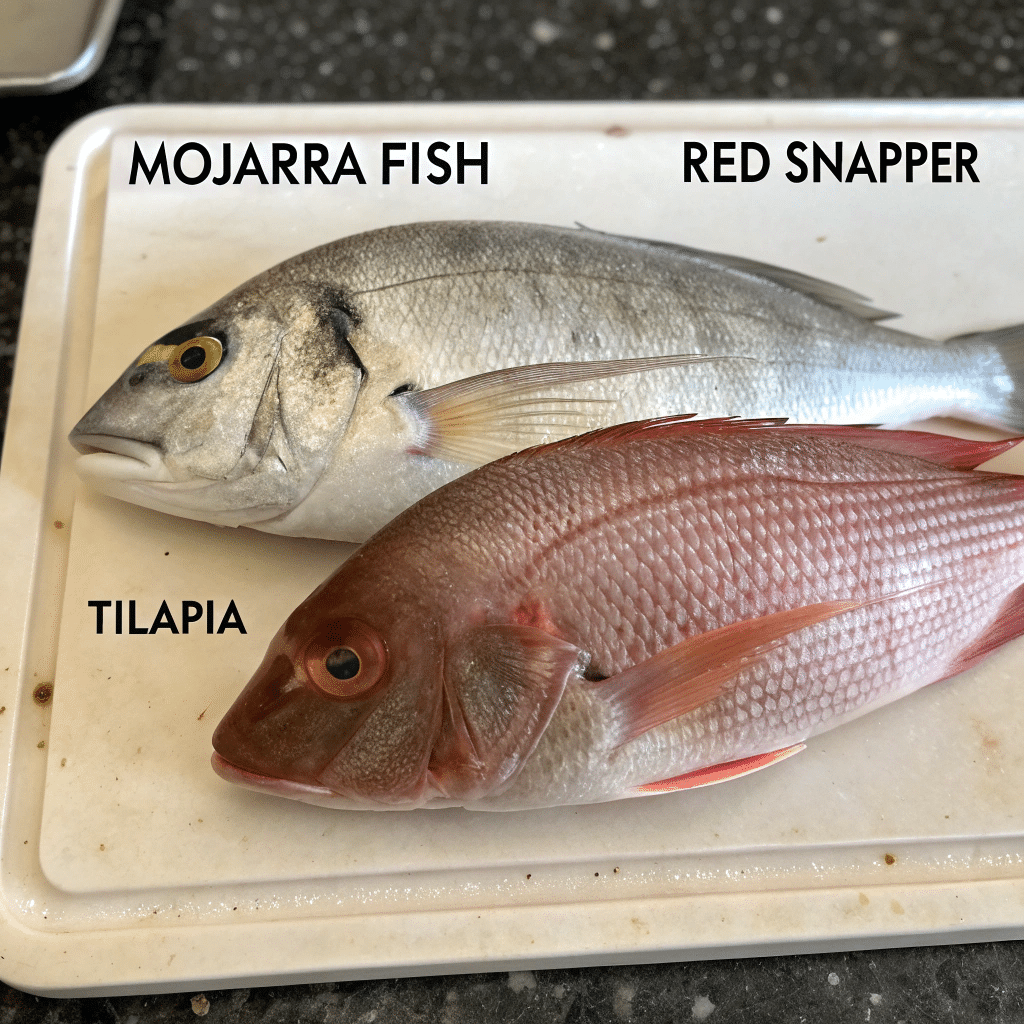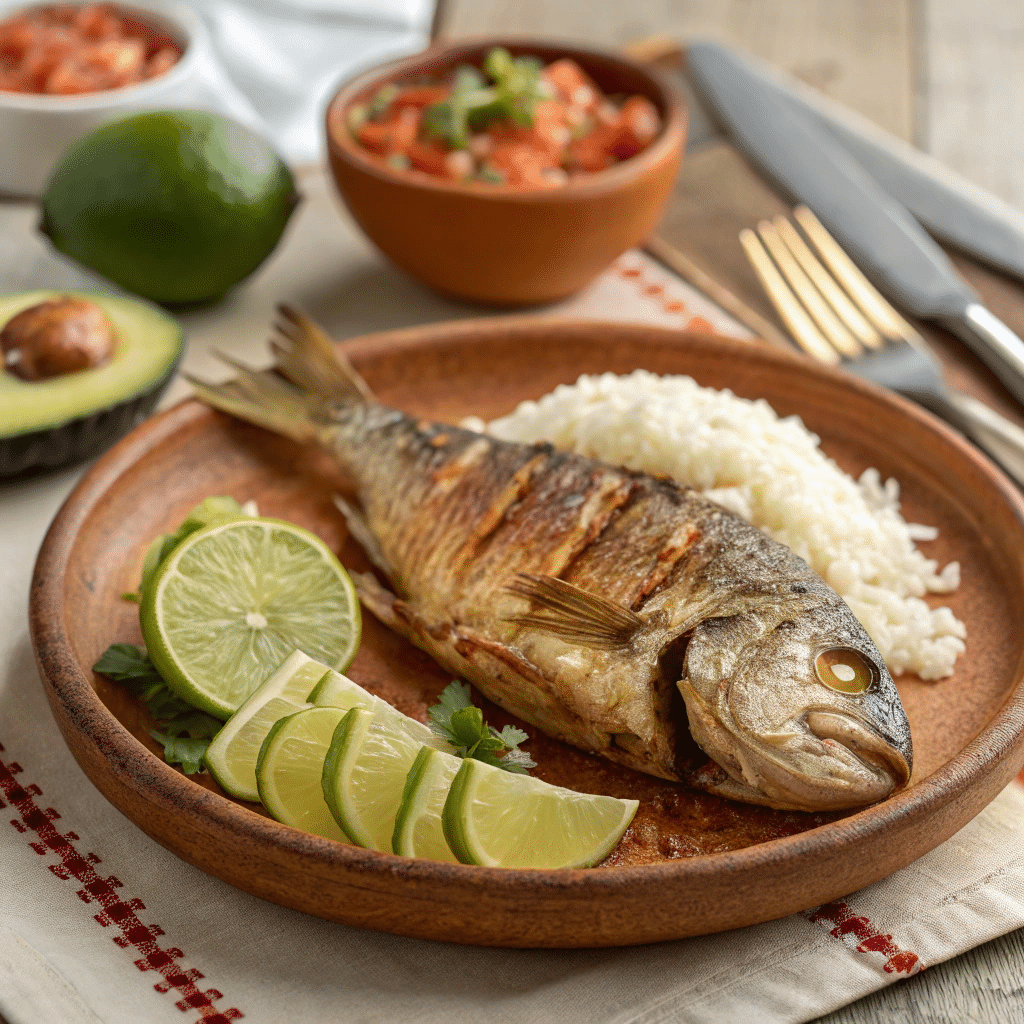Craving a dish that’s crispy on the outside, juicy on the inside, and packed with heritage? Mojarra fish might just be the catch you’re looking for. Popular across Latin America and gaining traction in U.S. kitchens, this freshwater favorite is more than just a meal—it’s a tradition. Whether fried, grilled, or baked, mojarra fish delivers rich flavor with a side of cultural pride.
In this article, we’ll explore everything from the different types of mojarra to their health benefits, and from cooking tips to how it compares with other popular fish like tilapia and snapper. We’ll also decode the meaning behind the name “mojarra” in Spanish and help you find the best ways to shop, store, and cook this beloved fish at home.
Don’t miss our Mojarra Frita Recipe Guide if you’re ready to cook it like a pro!
Introduction to Mojarra Fish
What Is Mojarra Fish?
Mojarra refers to a group of fish species commonly found in freshwater and coastal regions of Latin America, Africa, and Southeast Asia. While the name “mojarra” is often used in Mexican and Central American cuisine, it’s not tied to a single fish species. Instead, it includes several varieties from the Gerreidae family, and even commonly refers to tilapia in U.S. Latin markets.
In local markets, when someone says “mojarra,” they typically mean a small, oval-shaped fish served whole—head, tail, and all—fried to crispy perfection. It’s widely loved for its mild flavor, flaky texture, and ease of cooking.
Historical and Cultural Relevance in Latin America
Mojarra holds a special place in Latin American households and celebrations. It’s not just a weeknight dinner—it’s a Sunday family meal, a seaside indulgence, and a street food staple. In countries like Mexico, Colombia, El Salvador, and Guatemala, mojarra is deeply woven into the culinary fabric. The dish is often seasoned with lime, garlic, and spices before being fried and served with rice, salad, and tortillas.
In many fishing communities, catching and preparing mojarra isn’t just about sustenance; it’s a ritual. From riverside villages in Chiapas to coastal eateries in Cartagena, mojarra is a flavor that feels like home.
Check out the Tropical Smoothie Fat Burner if you’re pairing your mojarra with a refreshing sidekick.
Types of Mojarra Fish Around the World
Common Varieties and Their Characteristics
When people talk about mojarra, they’re often referring to a variety of species rather than just one. In fact, the term “mojarra” includes dozens of species primarily from the Gerreidae family. These fish are commonly found in tropical and subtropical waters, particularly in the coastal regions of the Americas and West Africa.
However, in Latin American markets—especially in the U.S.—tilapia is the most commonly sold fish under the name “mojarra.” Tilapia shares a similar body shape and texture and is widely farmed, making it a cost-effective substitute.
Here are some common types often referred to as mojarra:
| Type of Mojarra | Scientific Name | Description |
|---|---|---|
| Silver Mojarra | Eucinostomus gula | Small, silver-colored coastal fish |
| Sand Mojarra | Diapterus auratus | Found near river mouths and estuaries |
| Yellowfin Mojarra | Gerres cinereus | Common in warm shallow waters |
| Nile Tilapia | Oreochromis niloticus | Most common “mojarra” in U.S. markets |
Many of these species are caught fresh or farmed in Mexico, Honduras, or Colombia and exported for Latin American communities living abroad.
Mojarra vs. Other Popular Fish (Tilapia, Snapper, etc.)
Is mojarra tilapia? Not exactly—but the two are often interchangeable in recipes, especially in North America. Tilapia is not from the Gerreidae family but from Cichlidae. Still, the similar taste and cooking style make them culinary cousins.
On the other hand, snapper, particularly red snapper (Lutjanus campechanus), is also frequently confused with mojarra. Snapper is generally larger, with firmer flesh and a deeper flavor profile. Mojarra is typically smaller, milder, and more affordable.
Let’s break it down further:
| Feature | Mojarra | Tilapia | Snapper |
|---|---|---|---|
| Common Usage | Fried whole fish | Farm-raised, versatile | High-end seafood |
| Texture | Mild, flaky | Mild, soft | Firm, slightly sweet |
| Price Point | Affordable | Very affordable | More expensive |
| Size | Small-medium | Medium | Medium-large |
In essence, while mojarra may look like tilapia and cook like snapper, it has its own identity rooted in local tradition and accessibility.
Discover great ideas like Are Salt Water Taffy Gluten Free? if you’re interested in food identity and cultural ingredients.
Mojarra Fish in English – Names and Misconceptions

What Fish Is Mojarra Fish in English?
When it comes to mojarra fish, there’s a lot of confusion surrounding its name—especially when translated into English. So, what exactly is mojarra fish in English? The term doesn’t refer to just one species. In fact, mojarra fish is a general label used in Latin America and Spanish-speaking communities to describe various small, silver-colored fish commonly found in coastal and freshwater regions.
In U.S. supermarkets and Latin grocery stores, mojarra fish is most commonly used to label whole tilapia. While tilapia is technically not part of the Gerreidae family (which includes true mojarra species), it’s the fish you’ll most often find sold under the “mojarra” name due to its similar size, appearance, and taste. This practical adaptation makes mojarra fish more accessible to a global market, especially in Hispanic communities across the United States.
Here’s a quick breakdown of how mojarra fish is commonly labeled:
| Spanish Name | English Market Name | Actual Species |
|---|---|---|
| Mojarra | Whole Tilapia | Oreochromis niloticus |
| Mojarra Plateada | Silver Mojarra | Eucinostomus gula |
| Mojarra Amarilla | Yellowfin Mojarra | Gerres cinereus |
Whether you’re shopping at a Latin fish market or dining at a traditional Mexican restaurant, if you ask for mojarra fish, you’ll most likely be served a delicious, whole-fried tilapia seasoned with garlic, lime, and spices.
Is Mojarra Fish Snapper or Tilapia? Clearing the Confusion
A common culinary debate is whether mojarra fish is snapper or tilapia. Let’s set the record straight: mojarra fish is not snapper, though it’s often confused with it. Snapper belongs to the Lutjanidae family, which includes species like red snapper. Mojarra, however, includes various species from the Gerreidae family, and tilapia from the Cichlidae family is frequently labeled as mojarra fish in markets.
So, while mojarra fish and snapper can look similar on the plate—especially when fried—there are differences in taste, texture, and price. Snapper tends to be firmer and more expensive, while mojarra fish (usually tilapia) is mild, flaky, and affordable.
Here’s a quick comparison:
| Feature | Mojarra Fish (Tilapia) | Snapper |
|---|---|---|
| Texture | Flaky and mild | Firm and richer in flavor |
| Price | Budget-friendly | Premium |
| Common Preparation | Fried whole fish | Grilled or baked |
| Culinary Use | Latin dishes | Coastal cuisine |
So next time you order mojarra fish, know that it’s probably tilapia, prepared in a traditional Latin style that emphasizes flavor, texture, and presentation.
Don’t miss our Cottage Cheese Chips Recipe—a crunchy, high-protein snack that pairs beautifully with your next mojarra fish dinner.
Nutritional Profile and Health Benefits
Vitamins, Minerals, and Macronutrients in Mojarra Fish
When it comes to eating healthier without giving up flavor, mojarra fish is a standout choice. Not only is it incredibly versatile in the kitchen, but it also packs a solid nutritional punch. Whether you’re watching your waistline or trying to eat more whole foods, mojarra fish makes a smart addition to your plate.
Here’s a quick look at the average nutrition profile of one 3.5-ounce (100g) serving of cooked mojarra fish (typically tilapia):
| Nutrient | Amount |
|---|---|
| Calories | 128 kcal |
| Protein | 26 grams |
| Total Fat | 2.7 grams |
| Saturated Fat | 1 gram |
| Omega-3 Fatty Acids | 220 mg |
| Cholesterol | 50 mg |
| Sodium | 56 mg |
| Calcium | 10 mg |
| Iron | 0.9 mg |
| Vitamin B12 | 1.7 µg |
Mojarra fish is rich in lean protein and essential B vitamins, particularly vitamin B12, which supports brain function and energy production. It also contains a modest amount of omega-3 fatty acids, known for their heart-health benefits—even though it’s not as omega-rich as fatty fish like salmon or sardines.
Because it’s low in saturated fat and calories, mojarra fish is ideal for those aiming to maintain or lose weight without compromising on taste or satisfaction.
Is Mojarra Fish Good for Weight Loss and Heart Health?
Absolutely. If you’re looking to boost your diet with clean protein, mojarra fish is a fantastic option. Its high protein content helps you stay full longer, which can curb unnecessary snacking and promote healthy weight loss.
Thanks to its omega-3 content—even at moderate levels—mojarra fish supports heart health by reducing inflammation, lowering blood pressure, and improving cholesterol balance. It’s also easy to digest, making it great for people with sensitive stomachs or those recovering from illness.
Moreover, it’s naturally gluten-free, low in mercury, and widely available—making it a safer and more convenient choice for regular consumption.
And if you’re following a clean-eating or low-carb meal plan, a grilled or steamed mojarra fish fillet paired with vegetables fits perfectly.
Check out this Transfusion Drink Mocktail Recipe for a heart-healthy beverage to complement your next mojarra dish.
How to Cook Mojarra Fish – Traditional & Modern Methods
Classic Dishes: Mojarra Frita and Latin Fried Fish
When it comes to cooking mojarra fish, nothing beats the iconic mojarra frita—a beloved dish across Mexico, El Salvador, Guatemala, and beyond. This traditional preparation involves seasoning the whole mojarra fish with salt, lime juice, garlic, and sometimes achiote or paprika, then frying it until the skin turns golden and crispy.
The fish is usually served whole, bones and all, with popular sides like:
- Mexican rice or arroz rojo
- Sliced avocado
- Lime wedges
- Pickled onions
- Fresh tortillas or plantains
Mojarra frita isn’t just a dish—it’s an experience. Crackling skin, juicy interior, and bold flavors make it a favorite at family gatherings and seaside eateries alike.
Don’t miss our full Mojarra Frita Recipe Guide to try this recipe at home the authentic way.
Grilled, Baked, and Steamed Mojarra Techniques
While frying is the most well-known method, there are healthier and equally delicious ways to prepare mojarra fish that suit various dietary needs. Let’s explore them:
Grilled Mojarra
Grilling mojarra fish over charcoal or gas adds a smoky depth to its mild flavor. It’s best to marinate the fish with citrus, garlic, and herbs like cilantro or parsley for 30 minutes before grilling.
Pro Tip: Wrap the fish in banana leaves or aluminum foil to prevent sticking and retain moisture.
Baked Mojarra
For an easy weeknight dinner, baked mojarra fish is a winner. Preheat the oven to 375°F (190°C), season the fish with olive oil, lemon, and your favorite spices, then bake for 25–30 minutes. Add sliced vegetables like bell peppers or zucchini to the baking dish for a one-pan meal.
Steamed Mojarra
Want a low-fat option? Steaming mojarra fish preserves its nutrients and keeps it moist. Use a bamboo steamer or a metal rack over boiling water. Add ginger, garlic, and soy sauce for a subtle Asian twist.
Each of these cooking styles brings out different textures and flavors, but all honor the natural richness of mojarra fish.
Looking for a fun side idea? Pair your grilled mojarra with something light like our Tropical Smoothie Fat Burner for a refreshing combo.
Step-by-Step Recipe – Authentic Mojarra Frita
Ingredients, Prep Steps, and Cooking Tips

There’s something incredibly satisfying about frying a mojarra fish to crispy perfection. This dish—mojarra frita—isn’t just popular in Latin America; it’s a flavor-packed experience that brings culture right to your kitchen.
Here’s how to make it just like abuela used to.
Ingredients:
- 2 whole mojarra fish (cleaned and descaled; typically tilapia)
- 4 cloves garlic (minced)
- 1 tsp sea salt
- ½ tsp black pepper
- Juice of 2 limes
- 1 tsp paprika or achiote (optional, for color)
- ½ cup all-purpose flour (optional, for extra crunch)
- 1 cup vegetable oil (for frying)
- Fresh cilantro or parsley (garnish)
- Lime wedges (to serve)
Preparation Instructions:
- Clean and Score the Fish:
Rinse the mojarra fish under cold water. Pat dry. Make 2–3 diagonal cuts on each side to help the seasoning penetrate. - Season Well:
In a bowl, mix garlic, lime juice, salt, pepper, and paprika. Rub this mixture all over the fish, including inside the cavity and the cuts. Let it marinate for 15–30 minutes. - Optional Crunch:
Lightly coat each mojarra fish in flour. This creates a crispier finish when fried. - Heat the Oil:
In a large skillet, heat oil over medium-high. Once hot, gently slide the fish into the oil. Fry 5–7 minutes per side, or until golden and crispy. - Drain and Rest:
Transfer to a paper-towel-lined plate to drain excess oil. Sprinkle with sea salt and fresh herbs.
Pro Cooking Tips:
- Use a fish spatula or two forks to carefully flip the fish.
- Fry in batches to avoid overcrowding the pan.
- Don’t over-marinate in lime—it can “cook” the fish like ceviche.
Plating, Side Dishes, and Serving Suggestions
Mojarra frita is traditionally served with simple, flavorful sides that let the fish shine. Here’s how to build a perfect plate:
| Side Dish | Description |
|---|---|
| Arroz Rojo (Mexican Rice) | Savory tomato-based rice with peas and carrots |
| Fresh Avocado Slices | Cool, creamy contrast to the hot fish |
| Lime Wedges | A fresh squeeze brightens every bite |
| Pickled Red Onions | Adds tangy crunch and color |
| Corn Tortillas | Warm and soft to scoop every flaky bite |
For a balanced meal, pair with a refreshing agua fresca or a non-alcoholic mocktail like our Transfusion Drink.
Whether it’s for a Sunday lunch or a festive dinner, mojarra fish done this way turns any table into a celebration.
Buying and Storing Mojarra Fish
Where to Find Fresh Mojarra Fish (USA + International Markets)
Finding high-quality mojarra fish can be surprisingly easy if you know where to look. In the United States, your best bet is to visit a Latin or international grocery store, as these places often carry whole tilapia labeled as “mojarra.” Some major retailers like H-E-B, Fiesta Mart, Vallarta Supermarkets, and even select Walmart and Kroger locations may also carry it—especially in areas with large Hispanic populations.
Look for fish that:
- Have clear, shiny eyes
- Smell clean, like the ocean—not fishy
- Have firm, intact scales
- Feature red, healthy-looking gills
You can also buy frozen mojarra fish from brands specializing in Latin American imports. Just make sure the label indicates it’s whole and unseasoned so you have full control over flavor.
If you’re outside the U.S., fresh mojarra is commonly found in:
- Open-air markets in Mexico and Central America
- Local fisheries in Colombia, Ecuador, or the Philippines
- Wet markets across Southeast Asia, where similar species are common
Don’t hesitate to ask fishmongers for “mojarra” or whole tilapia—even if the label doesn’t say it, they’ll often know what you mean.
Check out our helpful Are Salt Water Taffy Gluten Free? to learn how to decode product labels and avoid confusion.
Best Practices for Storage and Freezing
To preserve the freshness and flavor of mojarra fish, follow these proven storage techniques:
Short-Term Refrigeration:
- Store whole mojarra fish in the coldest part of your fridge, ideally on a bed of crushed ice in a shallow tray.
- Cover it loosely with plastic wrap or foil and use within 1–2 days.
- If pre-seasoned, place in an airtight container to avoid cross-contamination.
Freezing Mojarra Fish:
- Clean and dry the fish thoroughly.
- Wrap each fish tightly in plastic wrap, then again in aluminum foil.
- Place inside a zip-top freezer bag labeled with the date.
- Store at 0°F (−18°C) for up to 3 months for best texture and taste.
To thaw, avoid the microwave. Instead, place the fish in the refrigerator overnight or under cold running water for a gentle defrost.
Proper storage not only keeps mojarra fish tasting fresh—it ensures safe consumption and reduces waste.
Discover great ideas like Cottage Cheese Chips Recipe to complement your frozen fish meal plans.
Mojarra in Spanish-Speaking Countries
What Does “Mojarra” Mean in Spanish Culture?
In Spanish-speaking countries, mojarra fish isn’t just a menu item—it’s a word loaded with regional identity, culinary memory, and local flavor. The term mojarra refers to various species of small, silvery fish—especially those served whole and fried. Depending on where you are, the word might point to different fish, but the cultural essence remains the same: rustic, comforting, and deeply traditional.
In Mexico, “mojarra” usually means tilapia, and it’s served whole in dishes like mojarra al mojo de ajo (with garlic sauce) or mojarra frita (fried fish). In Colombia, it’s often caught fresh from the Magdalena River and served at roadside eateries or with coconut rice on the Caribbean coast. Meanwhile, in El Salvador, mojarra fish is a prized catch in Lago de Ilopango, often eaten fried with curtido (pickled cabbage) and tortillas.
Beyond the plate, mojarra also carries idiomatic use in some dialects—sometimes as slang for a sneaky person or something hard to catch, reinforcing how deeply embedded this term is in the everyday language.
So, whether you’re dining in a small Mexican village or a Colombian fishing town, mojarra fish means more than just food—it’s part of a shared culinary heritage.
Don’t miss our Tropical Smoothie Fat Burner to enjoy a fresh Latin twist alongside your mojarra.
Regional Variations: Mexico, Colombia, Peru, and More
Let’s take a tour of how mojarra fish is interpreted and prepared across the Spanish-speaking world:
Mexico
- Typical Prep: Fried whole with lime and garlic
- Sides: Rice, beans, avocado, tortillas
- Notable Variant: Mojarra en salsa verde or red sauce
Colombia
- Typical Prep: Grilled or fried mojarra fish from rivers or lakes
- Sides: Coconut rice, patacones (fried green plantains), and salad
- Special Touch: Often cooked outdoors with wood fire
Peru
- Typical Prep: Grilled over open flame, sometimes used in ceviche (if small)
- Sides: Yucca, rice, and ají chili sauce
- Regional Flavor: Influenced by indigenous herbs and spices
Guatemala & El Salvador
- Typical Prep: Fried or grilled lake-caught mojarra fish
- Sides: Curtido, fresh tomato sauce, fried plantains
- Highlight: Heavily marinated and always served whole
This beautiful diversity in preparation shows how mojarra fish is more than just a species—it’s a canvas for Latin American culinary art.
Looking for inspiration? Try the Transfusion Drink to add a refreshing touch to your mojarra meal, no matter which country’s version you enjoy.
Sustainability and Environmental Impact

Is Mojarra Fish Farming Eco-Friendly?
As consumer awareness grows, more people are asking how sustainable their seafood choices really are. Fortunately, mojarra fish—most often referring to farmed tilapia—tends to be a more environmentally friendly option compared to overfished species like tuna or grouper.
Here’s why:
- Efficient Feed Conversion: Mojarra fish convert feed into protein very efficiently, which means they require fewer resources to grow.
- Low Trophic Level: Mojarra fish are herbivorous or omnivorous, which minimizes the need for fish-based feed that contributes to marine depletion.
- Adaptable Farming Conditions: They can thrive in freshwater ponds, making them ideal for sustainable aquaculture in developing countries.
However, not all mojarra fish farms are created equal. Poorly managed operations may contribute to:
- Water pollution
- Overuse of antibiotics
- Habitat destruction
To ensure eco-friendliness, look for fish labeled:
- Best Aquaculture Practices (BAP) Certified
- ASC Certified (Aquaculture Stewardship Council)
- Responsibly Farmed
If you’re buying mojarra fish in the U.S., especially from Latin markets, it’s often imported from certified farms in Mexico, Honduras, or Ecuador, where aquaculture practices are improving steadily.
Check out our Cottage Cheese Chips Recipe—a great low-waste snack to pair with your sustainable seafood dishes.
Wild vs. Farmed Mojarra Fish: What Consumers Should Know
So should you go for wild-caught or farmed mojarra fish?
Farmed Mojarra (Common Choice)
- Pros: Sustainable, affordable, consistently available
- Cons: Quality can vary by farm; not as flavorful as wild fish
- Best For: Everyday cooking, budget-conscious meals
Wild-Caught Mojarra
- Pros: Richer taste, fewer farming concerns
- Cons: Harder to find, can be overfished in some regions
- Best For: Special occasions, coastal authenticity
Ultimately, the best choice depends on your values and access. If you care about minimizing your environmental footprint while enjoying nutrient-rich meals, responsibly farmed mojarra fish is an excellent option.
Discover more great food insights in our Are Salt Water Taffy Gluten Free? breakdown—a helpful read for label-conscious shoppers.
FAQ Section: People Also Ask About Mojarra Fish
Are tilapia and mojarra the same fish?
Not exactly—but they are often used interchangeably. Mojarra fish is a general term in Latin America and the U.S. Hispanic market that often refers to whole tilapia, especially in culinary contexts. Technically, tilapia belongs to the Cichlidae family, while true mojarra species fall under the Gerreidae family. Still, when you see “mojarra” at a store or restaurant in the U.S., it’s usually a whole tilapia fish prepared Latin-style.
What fish is mojarra in English?
In English, mojarra fish doesn’t refer to one specific species. It can mean various types of small, silver-colored fish. Most commonly, it refers to whole tilapia, especially in Latin American cuisines. Other species labeled as mojarra include silver mojarra (Eucinostomus gula) and yellowfin mojarra (Gerres cinereus). So the “English name” depends on the region and culinary context.
Is mojarra snapper?
No, mojarra is not snapper, though they’re often confused due to similar preparation styles. Snapper belongs to the Lutjanidae family and is known for its firm, sweet flesh. Mojarra fish, on the other hand, typically refers to smaller, milder fish like tilapia. Both may be fried whole and served with Latin sides, but they are entirely different species.
What does mojarra in Spanish mean?
In Spanish, mojarra refers to a group of small fish commonly served whole, especially in fried preparations. The term also appears in regional slang across Latin America. For example, in Colombia, “mojarra” may mean “a sneaky person” or even be used humorously. In the kitchen, though, it almost always means a flavorful, whole-fried fish that’s a family favorite.
Conclusion: Why Mojarra Fish Deserves a Spot in Your Kitchen
From its flavorful flesh and cultural roots to its versatility in the kitchen, mojarra fish is more than just a traditional meal—it’s a celebration of Latin cuisine. Whether you fry it, grill it, or bake it, mojarra delivers on taste, nutrition, and accessibility. It bridges tradition with modern health trends and works beautifully in meals for any occasion.
With a low environmental footprint, a variety of regional recipes, and easy availability, mojarra fish is a delicious and smart choice for your next seafood dish.Don’t miss to visit our page facebook.
Don’t miss our Mojarra Frita Recipe Guide to master the ultimate Latin fried fish recipe at home.

